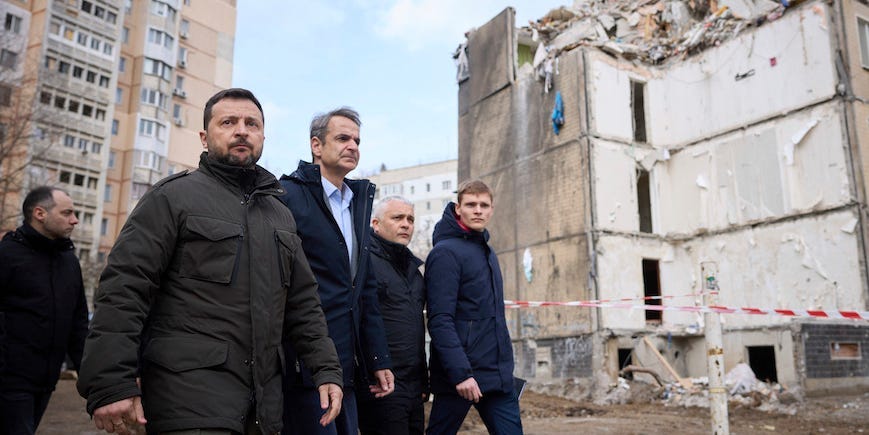Last week, Russia launched a deadly missile strike on the Ukrainian city of Odesa just as Greek Prime Minister Kyriakos Mitsotakis was visiting its port.
“We heard the sound of sirens and explosions that took place near us,” Mitsotakis said, per The Guardian, adding that there wasn’t time to reach a shelter.
Many details are still emerging about the incident, but sources told Reuters that the strike hit less than half a mile from Mitsotakis.
It incited international outrage, and was far from an isolated incident.
In the two years since Russian President Vladimir Putin launched his full-scale invasion, allied dignitaries visiting Ukraine have been harried by strikes — and in one case, a drone — in the cities they’ve visited.
Air raid sirens went off during President Joe Biden’s visit to Kyiv in February last year.
Russian strikes also cast a shadow over the visits of top EU diplomat Josep Borrell, UN Secretary-General António Guterres, as well as German President Frank-Walter Steinmeier.
Many of these strikes killed Ukrainian civilians, which has become part of Putin’s modus operandi in the war.
As such, it’s unclear whether all of these incidents point to a single strategy — or are, indeed, intentional, said Cristian Nitoiou, a senior lecturer in diplomacy and international governance at the UK’s Loughborough University.
“Definitely, I think Russia has been trying to be quite aggressive and intimidate Western leaders,” he told Business Insider.
However, he said he doubts that there is a plan “to actually kill or specifically target a key policymaker from the European Union or from the United States.”
Even so, there’s clear menace involved.
Evan Vucci/AP Photo
In February, a Russian drone ominously tailed German Defense Minister Annalena Baerbock in the southern city of Mykolaiv, sending her and her retinue scurrying away. Russia frequently uses drones to help target artillery strikes.
Both Nitoiou and Rafael Loss, a policy fellow at the European Council on Foreign Relations, told BI that events like this will have set off intense diplomatic discussions with Moscow.
Incidents like these also signal that Russia is far more willing to escalate matters in Ukraine than Ukraine’s allies are, Loss said.
What happens if someone gets hit?
Imagine, for a second, that one of these world leaders was actually hit.
NATO’s principle of collective defense — Article 5 — doesn’t apply to armed attacks in this scenario as they would not be in NATO space, Loss told BI.
But it could trigger Article 4, where NATO states consult each other on what to do in response.
“And out of that could emerge some kind of diplomatic, political, economic, or even military response,” Loss said.
Contributor via Getty Images
How an affected country reacts may depend on how hawkish it is toward Russia, Nitoiou added.
Countries like Poland and the Baltic states — which have long been wary of their larger neighbor and are vocal about the possibility of a larger conflict — are more likely to escalate with unilateral action, he said.
But the most likely scenario is that none of Ukraine’s allies would opt for a military escalation, he said.
Russia is ‘greasing’ a slippery slope
Russia is testing NATO’s attitude to risk, Loss told BI, and the incidents involving leaders visiting Ukraine can be read as part of a much wider strategy of provocations.
“Any conflict crisis can be described as a sort of slippery slope towards escalation, but I think over the past two years we’ve seen that Russia is sort of deliberately greasing the slope in many ways,” he said.
He pointed to when a Russian missile was deemed to have entered NATO airspace by passing over Poland in late December.
In March last year, a Russian fighter jet also clipped a US Reaper drone over the Black Sea and caused it to crash.
JOHN THYS/AFP via Getty Images
Actions like this aim to manipulate Ukrainian allies’ attitude to risk, stalling them from helping over fears that it would prompt an escalation, Loss argued.
“Russia is trying to shape this by creating these kinds of risks and uncertainties very much in the minds of Western policymakers,” he said.
Loss believes that French President Emmanuel Macron’s recent suggestion that NATO troops could be deployed to Ukraine — albeit in a nonlethal capacity — is a way of pushing back on this.
It would be a way to make Putin think more about potential escalations if French soldiers were killed, he said.
As it is, Russia seems “very comfortable” raising the stakes while Western countries continue to urge restraint, Loss said.
Incidents like the one with the Greek prime minister last week “certainly point to a growing confidence on the Russian side that there’s not going to be any consequences for these kinds of activities,” he added.



